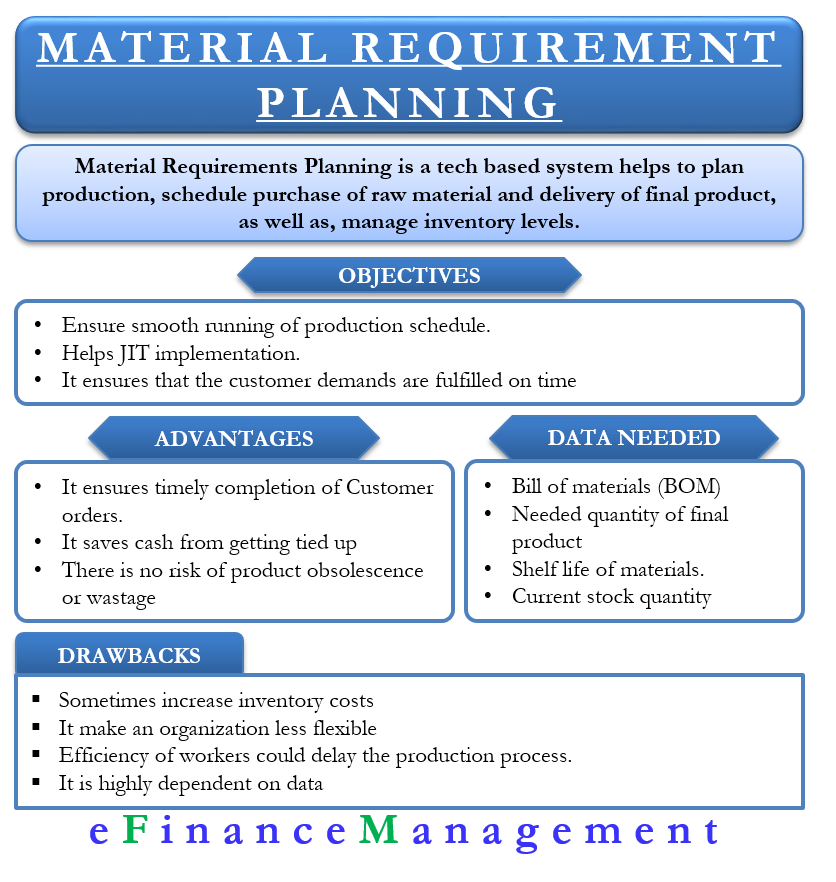Material Requirements Planning or MRP is an inventory management system that uses computers and software. This tech-based system works backward from customer orders. It answers three questions – What is needed? How much is required? When is it required?
It determines when the company would need materials for production, and on this basis, it orders the materials, whose delivery will coincide with the manufacturing dates. After that, the system generates the delivery dates for the final product.
In a nutshell, we can say that MRP helps plan production, schedule the purchase of raw material and the delivery of the final product, and manage the inventory levels.
Material Requirements Planning – History
Joseph Orlicky, Ph.D., is the developer of this inventory management system. While working at J.I. Case, he developed this to challenge Toyota’s new lean production system. Initially, this system was not dependent on a computer. Instead, it was an arithmetical system useful for primary production control.
After it was made computer-based, the system grew faster and more accurate. In 1964, the first company to test this was Black & Decker. Since then, the MRP has become more holistic and includes data from all stakeholders, such as suppliers, marketing, human resources, and more. We can also call this new and improved system as MRP II.
Objectives of MRP
This inventory management system primarily severs the following objectives
- It helps to ensure the smooth running of the production schedule. MRP does this by making ensuring that the raw materials are available as per the production requirement.
- It helps the company to implement Just-in-Time (JIT) material procurement efficiently.
- Material requirement planning or MRP ensures that the customer demands are fulfilled on time.
Advantages of MRP
Efficiently implementing MRP could prove very profitable for a company in the following ways:
- Since MRP ensures that the customer orders are completed on time, it prevents the orders from getting canceled. Thu MRP, in turn, boosts revenue.
- MRP prevents a company from ordering extra (or more than needed) raw material and components. So, this saves cash from getting tied up. The company can use this cash for other productive purposes.
- Since there is no excess inventory, there is no risk of product obsolescence or wastage.

Data Needed for MRP
As said above, MRP needs data from all departments to manage the system efficiently. However, a few data points are more important than others. These are:
- Bill of materials (BOM) includes the names of all the raw materials, components, and assemblies that a company needs to make a product or service.
- The quantity of final product that a company needs and when the customer needs it.
- The shelf life of materials.
- Items that the company currently has in inventory. These include the materials in stock and also those in the pipeline from suppliers.
- Detailed data to properly plan, such as production process, labor and machine standards, lot sizing techniques, and more.
Drawbacks of MRP
Following are the drawbacks of MRP:
- MRP systems can sometimes increase inventory costs. Since MRP helps to anticipate shortages early, it may result in overestimating the lot sizes and lead times. Such cases have more probability of happening when the MRP system is new or when the managers don’t have much experience in handling extreme cases.
- It may also make an organization less flexible. MRP requires that the management sticks to the master production schedule for better results. However, if there is an emergency, then MRP has no backup plan.
- Factors such as the efficiency of workers could delay the production process.
- Successful implementation of MRP is highly dependent on data, especially the data on demand and inventory. So, if the information is inaccurate, it could seriously compromise the result.
MRP vs. ERP
MRP II (mentioned above) is a more holistic form of MRP. And in 1990, analyst firm Gartner further expanded the scope of MRP II, and the resultant concept was named enterprise resource planning (ERP).
With the improvement to MRP II (or ERP), other industries were also quick to adopt this inventory management system, such as services, banking, and retail. The extra items that ERP considers are cash management, asset tracking, quality management, marketing automation, customer relationship management, and more.
Also Read: Inventory Management Techniques
ERP, however, due to its extensive scope, suits large-scale businesses. On the other hand, all types of companies can use MRP. Also, ERP is much more expensive in comparison to MRP. But, ERP justifies the cost if we consider the number of functions that it offers.
Keep reading Inventory Management Techniques to know more about other techniques.
Final Words on MRP
Material Requirements Planning is one of the most popular inventory management systems globally. Despite the shortcomings, companies use it to optimize their production. Moreover, companies use advanced planning and scheduling (APS) software to overcome its shortcomings. APS uses sophisticated math and logic to come up with more accurate information on the lead times.
RELATED POSTS
- Types of Inventory / Stock
- MRO Inventory – Meaning, Importance, How to Manage
- How EOQ helps in Inventory Management?
- Direct Materials Budget: Meaning, Components, Format, Advantages, and Variance Analysis
- Cost Accounting Systems – Meaning, Importance And More
- ABC Analysis – Meaning, Categorization, Advantages, Disadvantages and Treatment

